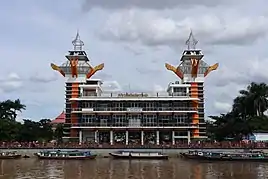Banjarmasin
Banjarmasin is a city in South Kalimantan, Indonesia. It was the capital of the province until 15 February 2022. The city is located on a delta island near the junction of the Barito and Martapura rivers. Historically the centre of the Banjarese culture, and the capital of the Sultanate of Banjar, it is the biggest city in South Kalimantan and one of the main cities of Kalimantan. The city covers an area of 98.46 km2 (38.02 sq mi) and had a population of 625,481 as of the 2010 Census[5] and 657,663 as of the 2020 Census;[6] the official estimate as of mid 2022 was 667,489 (comprising 334,110 males and 333,379 females).[3] Greater Banjarmasin, also known as Banjarbakula, is an urban agglomeration of around two million people covering an area of 8,136 km2 (3,141 sq mi), which includes Banjarbaru city and parts of Banjar Regency, Barito Kuala Regency, and Tanah Laut Regency, and accounts for almost half of the province's population. It is the third most populous city on the island of Borneo.[7][8]
Banjarmasin | |
|---|---|
| Other transcription(s) | |
| • Jawi | بنجر ماسين |
Clockwise from top: Banjarmasin seen from above, Soetji Nurani Chinese Temple, Banjarmasin watchtower, and Banjarmasin floating market. | |
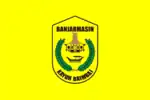 Flag  Coat of arms | |
| Nicknames: Kota Seribu Sungai (Indonesian: City of Thousand Rivers)
[1] | |
| Motto: | |
 Location of Banjarmasin within South Kalimantan | |
Interactive map outlining Banjarmasin | |
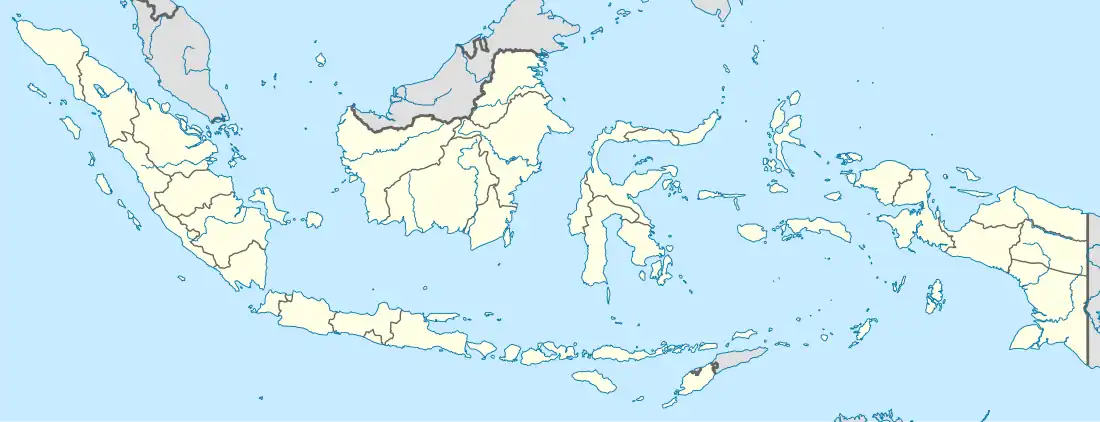 Banjarmasin Location within Indonesia | |
| Coordinates: 03°19′12″S 114°35′33″E | |
| Country | |
| Region | Kalimantan |
| Province | |
| Established | 24 September 1526 |
| Government | |
| • Mayor | Ibnu Sina |
| • Vice Mayor | Hermansyah |
| Area | |
| • City | 98.46 km2 (38.02 sq mi) |
| • Metro | 3,404.46 km2 (1,314.47 sq mi) |
| Elevation | 1 m (3 ft) |
| Population (mid 2022 estimate) | |
| • City | 667,489 |
| • Density | 6,800/km2 (18,000/sq mi) |
| • Metro | 2,184,427 |
| • Metro density | 640/km2 (1,700/sq mi) |
| [3] | |
| Time zone | UTC+8 (WITA) |
| Area code | +62 511 |
| HDI (2019) | |
| Website | www.banjarmasinkota.go.id |
Banjarmasin was the de jure seat of the South Kalimantan governor and the location of the provincial parliament, although some provincial buildings have been relocated to Banjarbaru.[9][10] On 15 February 2022, the capital of South Kalimantan province was legally moved to Banjarbaru.
History
Negara Dipa (1380–1478)
Negara Daha (1478–1520)Banjar Sultanate (1520–1526)
Demak Sultanate (1526–1546)Banjar Sultanate (1546–1635)
VOC (1635–1638)
Banjar Sultanate (1638–1701)
England (1701–1707)
Banjar Sultanate (1707–1787)
Dutch Republic (1787–1795)
Batavian Republic (1795–1806)
Dutch East Indies (1806–1809)
Banjar Sultanate (1809–1815)
Kingdom of Great Britain and Ireland (1815–1816)
Dutch East Indies (1817–1942)
Empire of Japan (1942–1945)
Dutch East Indies (1945–1949)
Indonesia (1949–today)
Etymology
"Banjarmasin" is thought to be a corrupted version of "Bandar Masih" (Port Masih), which was named for Patih Masih, who ruled the port and the surrounding villages. Patih Masih's name may have been a nickname. Masih originates from the Ngaju language. Oloh Masi refers to the coastal-dwelling Malay population in the language of the Dayaks, who lived in the interior and visited the port regularly to trade. Some of the Dayaks eventually settled in the port. They eventually contributed to the culture of the Banjar people, along with the Javanese and Malays.[11][12]
Early history

European archeologist H. Kupper discovered several prehistoric sites around the region in 1939 and found implements such as choppers and other stone tools. Most of the artifacts found around the region and the province show signs of Neolithic culture. Migration from mainland Asia to Borneo may have been common while they were connected by the Sunda Shelf. Many stone tools have been found in Awang Bangkal, 50 km (31 mi) from the city.[11]
Until the early 15th century, there were few written records found from the region. Outside records indicate it was home to several kingdoms such as Tanjungpuri—theorized to have been founded by Malay people from Srivijaya—and Negara Daha and Dipa, which were founded by Javanese people from Majapahit. Hinduism and Buddhism entered the region between the first and 15th centuries. There are two candis (temples) left in the region, Candi Laras and Candi Agung.[13] The Ma'anyan people may have ruled the oldest kingdom in the archipelago, Nan Sarunai. Its existence is disputed;[14][11][15] speculated by archeologists based on several carved stone tombs and a Ma'anyan folk song called "Usak Jawa", which is thought to tell the story of the Majapahit conquest of the kingdom.[15]
The history of Banjarmasin itself began during the founding of the Sultanate of Banjar. According to folk stories and the Hikayat Banjar, Sukarama, the fourth king of Negara Daha, wanted his grandson, Raden Samudra, to be his successor in the kingdom instead of his direct son Prince Tumenggung. Prince Tumenggung later banished Raden Samudra and tried to reclaim the throne for himself. Raden Samudra fled to the region that would later be known as Banjarmasin. There, he met Patih Masih. Under Samudra's leadership, the port grew into the town of Bandar Masih.[16][11] Tumenggung, who disliked Samudra's growing power, wanted to invade the town. Samudra allied with the Demak Sultanate, which agreed to help him. In return he would have to convert to Islam if he won. With the help of expeditionary forces from Demak, Samudra defeated the Tumenggung forces and proclaimed the Banjar Sultanate. He changed his name to Sultan Suriansyah I. The sultanate became more reliant on the Demak to the point that it was considered their protectorate. However, between 1546 and 1550, as conquests and the spice trade enriched the sultanate, it became independent and stopped sending tributes to Java.[11][17]
Colonial era

The first contact between Europeans and the Banjar people in the region came through trade. Starting in 1596, this mostly took place in Banten. European traders, largely Dutch, did not bother visiting the port until Banten's rulers banned them. The traders resorted to attacking ships from other countries, including ships under the Banjar Sultanate, to steal nutmeg. The Sultan took revenge against a Dutch ship visiting Banjarmasin on 17 July 1607 by hijacking it and massacring the crew. Similar incidents occurred several times between 1603 and 1636, ending when the sultanate reached a trade agreement that put the Dutch East India Company in control of the nutmeg trade from the sultanate and gave it a monopoly over trade in Banjarmasin. The company was expelled in 1638, however, after the sultan waged a war against the Dutch and burned much of the company's possessions around the port.[18][11]
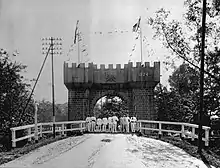
Similarly, an English company agreed upon a treaty with the sultanate in 1698 but was expelled from the region in 1707. The region was under British control after the Napoleonic Wars, but the British ceded it the Dutch East Indies Company under the Treaty of London.[11][17] A succession crisis between Sultan Adam and Tamjidillah II and a dispute over resource control of coal mines resulted in a war between the sultanate and the Dutch East Indies Company which led to the end of the sultanate in 1863. The war continued until 1905 under an emergency government set up by the sultanate called Pagustian. The last resistance was put down with the capture of Queen Zaleha in 1906.[17][19] As a result of the war, many Banjar people from Borneo migrated to Sumatra, Singapore, and Malaysia and formed communities there.[19]
20th century–present
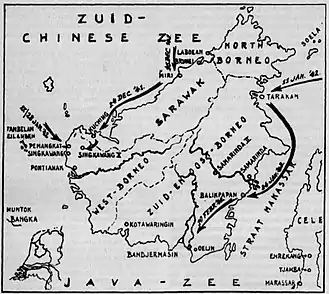
When World War II broke out, the city was occupied by the Imperial Japanese Army. After the Battle of Banjarmasin, control was transferred to the Imperial Japanese Navy. Locals described Japanese rule under the navy as harsher compared to the army. This led many people to escape to Java, which remained under army rule. The city was liberated by Australian forces in September 1945. The return of Dutch rule, however, was opposed by the people and resulted in the Kalimantan Physical Revolution, four years of war between Indonesian nationalists and the Royal Netherlands East Indies Army. This ended with the Dutch recognition of Indonesia in 1949. The city was briefly assigned as the capital of Great Dayak federal state before being absorbed into a single Kalimantan province. It later became the capital city of the newly formed South Kalimantan province.[11][20][21] Frequent flooding led to a plan to relocate the provincial capital city to Banjarbaru. The process continued until 2011, and the provincial parliament remains in Banjarmasin.[22] Banjarmasin was granted city status by the Indonesian government in 1959 under Law Number 27 of 1959.[7]
On 7 December 1996, Dirgantara Air Service Flight 5940 crashed to the gas factory after taking off near Syamsudin Noor International Airport, killing around 18 people.[23] On 23 May 1997, the city witnessed a riot caused by friction between supporters of the United Development Party and Golkar. The riot later developed into looting, which targeted Chinese and Christian minorities and several shopping malls.[24][25][26] At least least 137 people were killed during the riots.[27] The riot today is known by locals as Jumat Kelabu or Grey Friday.[28]
On 15 February 2022, the capital of South Kalimantan province was legally moved to Banjarbaru.[29][30]
Geography
Banjarmasin is located in the Barito River's basin and is bisected by the Martapura River. The slope of the city is 0.13% and the land is generally flat and low-lying. The geological foundation of the city is dominated by clay and sandstone, but also includes alluvial sediments from the river. Several smaller rivers, all connected to either the Martapura River or Barito River, form a dendritic drainage pattern. The city's river system is affected by tides. The city is located in a swampy region and is generally below water level, making it prone to being flooded by tidal bores.[31][10]
The area of city proper is 98.46 km2 (38.02 sq mi), around 0.26% of the provincial area.[10] It borders the Barito Kuala Regency in the north and west and the Banjar Regency in the east and south.[10]
Climate
Banjarmasin has a tropical savanna climate (Aw) with heavy rainfall from November to June and moderate rainfall from July to October. The monthly temperature is within range between 26 °C (79 °F) to 38 °C (100 °F) with an average maximum temperature of 33 °C (91 °F) and average minimum temperature of 22 °C (72 °F). However, there is a slight variation of seasonal temperatures because of monsoons. Precipitation can reach between 2,400 mm (94 in) and 3,500 mm (140 in) yearly, with an average level of 1,600 mm (63 in). The hottest months are between March and September when the temperature can reach an average as high as 36 °C (97 °F). The average amount of sunshine is 2.8 hours per day during the rainy season and 6.5 hours during the dry season.[10][31]
January is the wettest month, with air humidity sitting between 75 and 90% in January; September is the driest, with humidity of 52% in September.[31]
| Climate data for Banjarmasin (Syamsudin Noor International Airport, 1991–2020 normals) | |||||||||||||
|---|---|---|---|---|---|---|---|---|---|---|---|---|---|
| Month | Jan | Feb | Mar | Apr | May | Jun | Jul | Aug | Sep | Oct | Nov | Dec | Year |
| Average high °C (°F) | 32.2 (90.0) |
32.4 (90.3) |
32.7 (90.9) |
33.0 (91.4) |
33.2 (91.8) |
32.8 (91.0) |
32.7 (90.9) |
33.4 (92.1) |
33.9 (93.0) |
33.9 (93.0) |
33.2 (91.8) |
32.3 (90.1) |
33 (91) |
| Daily mean °C (°F) | 26.3 (79.3) |
26.4 (79.5) |
26.5 (79.7) |
26.7 (80.1) |
26.9 (80.4) |
26.5 (79.7) |
26.1 (79.0) |
26.2 (79.2) |
26.5 (79.7) |
26.8 (80.2) |
26.6 (79.9) |
26.2 (79.2) |
26.5 (79.7) |
| Average low °C (°F) | 23.7 (74.7) |
23.8 (74.8) |
23.9 (75.0) |
24.1 (75.4) |
24.1 (75.4) |
23.5 (74.3) |
22.6 (72.7) |
22.3 (72.1) |
22.6 (72.7) |
23.3 (73.9) |
23.8 (74.8) |
23.8 (74.8) |
23.5 (74.3) |
| Average precipitation mm (inches) | 334.1 (13.15) |
291.4 (11.47) |
261.4 (10.29) |
211.3 (8.32) |
152.5 (6.00) |
124.6 (4.91) |
92.2 (3.63) |
56.6 (2.23) |
63.7 (2.51) |
122.0 (4.80) |
232.0 (9.13) |
357.4 (14.07) |
2,299.2 (90.52) |
| Average precipitation days (≥ 1.0 mm) | 20.7 | 17.2 | 17.3 | 14.9 | 13.5 | 11.6 | 9.5 | 6.4 | 6.6 | 11.9 | 16.5 | 21.1 | 167.2 |
| Mean monthly sunshine hours | 99.9 | 95.1 | 117.7 | 130.1 | 148.3 | 134.0 | 150.1 | 159.5 | 146.6 | 136.5 | 118.3 | 93.4 | 1,529.5 |
| Source: World Meteorological Organization[32] | |||||||||||||
Governance

Administrative division
The city is divided into five districts (kecamatan). The most densely populated district is Central Banjarmasin with a density of 13,155 per square kilometre while the least densely populated district is South Banjarmasin with density of 4,281 per square kilometre. As of 2020, South, North, and East Banjarmasin district experienced population growth—South and North both by 1.10% and East by 0.58%; Central and West Banjarmasin both experienced declines of 0.46%. Their areas and populations at the 2010 Census[5] and 2020 Census,[6] together with the official estimates as at mid 2022,[3] are tabulated below. The table also includes the locations of the district administrative centres, the number of urban villages (kelurahan) in each district, and its postal codes.
| Name of District (kecamatan) | Area in km2 | Pop'n Census 2010 | Pop'n Census 2010 | Pop'n Estimate mid 2022 | Admin centre | No. of villages | Post code |
|---|---|---|---|---|---|---|---|
| Banjarmasin Selatan (South Banjarmasin) | 38.30 | 146,068 | 163,948 | 167,928 | Kelayan Selatan | 12 | 70241 - 70249 |
| Banjarmasin Timur (East Banjarmasin) | 24.50 | 111,318 | 118,389 | 119,847 | Kuripan | 9 | 70234 - 70239 |
| Banjarmasin Barat (West Banjarmasin) | 13.11 | 143,461 | 136,964 | 137,113 | Pelambuan | 9 | 70112 - 70245 |
| Banjarmasin Tengah (Central Banjarmasin) | 6.65 | 91,700 | 87,479 | 87,574 | Teluk Dalam | 12 | 70111 - 70241 |
| Banjarmasin Utara (North Banjarmasin) | 16.90 | 132,934 | 150,883 | 155,027 | Alalak Utara | 10 | 70121 - 70127 |
| Totals | 98.46 | 625,481 | 657,663 | 667,489 | 52 |
Local government
As with all Indonesian cities, Banjarmasin is a second-level administrative division run by a mayor and a vice mayor together with the city parliament, and is equivalent to a regency.[33] Executive power is vested in the mayor and vice mayor, while legislative duties are vested in the local parliament. The mayor, vice mayor, and parliament members are directly elected by the people of the city in an election.[34] Heads of districts are appointed by the mayor on the recommendation of the city secretary.[35][36]
Politics
On the provincial level, Banjarmasin is part of South Kalimantan's first electoral district, which has 8 out of 55 representatives. On the city level, the city is divided into five electoral districts, which have a total of 45 parliamentary representatives. The last election was in 2019 and the next one is scheduled for 2024.[37]
| Electoral district | Region | Representatives |
|---|---|---|
| Banjarmasin 1st | Central Banjarmasin District | 6 |
| Banjarmasin 2nd | North Banjarmasin District | 10 |
| Banjarmasin 3rd | East Banjarmasin District | 8 |
| Banjarmasin 4th | South Banjarmasin District | 11 |
| Banjarmasin 5th | West Banjarmasin District | 10 |
| Total | 45 | |
Economy
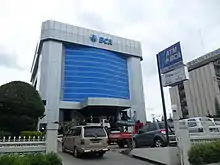
The city's economy is dominated by manufacturing, which accounts for 17.19% of its gross regional product (GRP) as of 2020. The second largest sector is trade, which accounts for 12.57% of the city's GRP, followed by the finance sector at 12.29%. The agriculture sector is small, contributing only 2.43% of city's GRP. Mining is nonexistent within the city, in stark contrast to neighbouring regions. In 2019, economic growth was 6.38%. However, in 2020 there was an economic downturn caused by the COVID-19 pandemic, resulting in a decrease of 1.91%. The city imports 1,900,000 long tons (1,900,000 t) of goods through its main port, the Port of Trisakti, and exports 98,320,000 long tons (99,900,000 t) of goods as of 2019. Movement of goods increased 92.24% between 2018 and 2019. Banjarmasin experienced 4.15% yearly inflation in 2019.[38][10]
Industry
Around 62% of industry in Banjarmasin is focused on food and drink processing and related products. This includes bread, flour, and soybean sauce production. Other industries include rubber and plastic manufacturing, which account for about 15% of the city's industrial output. The rest of the industrial output is from machinery, pharmaceuticals, paper products, and electrical equipment.[39]
There are 3,014 industrial companies registered in the city as of 2020, employing a total of 22,063 people. There are also smaller-scale industries producing wood furniture, clothing, and snacks, with 88 registered smaller-scale businesses in these sectors as of 2020.[10]
Tourism
The city has 129 hotels registered as of 2020. The city was visited by 109,653 domestic tourists and 251 foreign tourists that year. According to Statistics Indonesia, in 2020 there were 113 identified potential tourist spots in the city. Tourism, however, remains a small sector in the city's economy.[10]
Finance
The finance sector in general has been grew steadily from 2015 to 2019, with an annual growth of around 3%. Basic financial services account for 67% of this sector, followed by pension funds and insurance services with 14.94%. The city accounts for 67.61% of financial activities in the entire province, both in local and foreign currencies.[38]
Demographics
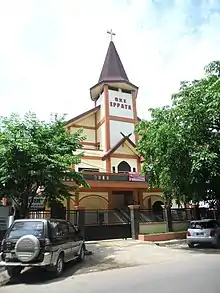
According to Statistics Indonesia, a resident of the city is defined as "someone who resides within the city for at least 6 months or less than 6 months but with intention to settle". The estimated number of residents in 2020 was 657,663 with a sex ratio of 100.36 male per 100 female. 47.87% of the city population resides in the South and North Banjarmasin districts. As with most of Indonesian cities, the population is young and consists of a workforce within the reproductive age of above 15, which in the city is around 62.07% of the city's population in 2020, or 331,526 people. Annual population growth was 0.44% between 2010 and 2020. East and Central Banjarmasin district. however, has a sex ratio of 98.84 and 97.47 male per 100 female respectively, which means both districts have more female residents than males. This differs from the city average. The city's dominant religion is Islam, with a minority of Protestants, Catholics, Hindus, Buddhists, Confucianists, and animist religions. Muslims make up around 95% of the city's population, followed by Christians (both Catholics and Protestants) at around 3%; other religions combined total about 2%.[10]
Most of the city's population identifies as Banjarese—79,26% did so in 2010. Other ethnicities include Javanese with 10.27%, Madurese with 3.17%, Chinese Indonesian with 1.56%, Dayak with 0.92%, and Bugis with 0.6%.[40] There is also an Arabic population that date back to Sultanate and colonial era.[40]
Education
The literacy rate in 2020 was 98.94%. There are 311 kindergartens, 208 elementary schools, 35 junior high schools, and 29 senior high schools as of 2020. There are also 22 vocational high schools in the city. The city is home to more than 25 higher education institutions and universities. One of the most notable, which is also a public university, is the Lambung Mangkurat University. The university has more than 2,000 graduates every year—most of them majoring in teaching and science education, followed by economics and business, engineering, agricultural science, and medical subjects. In 2020, there were 700 postgraduate students. A developed education system and the existence of educational institutions attract students from neighbouring regions to pursue their education in the city.[41][10] Other notable private universities, such as the Muhammad Arsyad Al-Banjari Kalimantan Islamic University, have the greatest number of students. According to Indonesian Statistics, in 2020 there 11,854 male and 8,189 female students. The school participation rate was 97.91% as of 2020.[10][42]
Healthcare
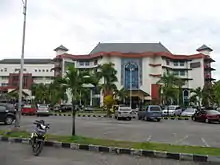
The city has eight hospitals and 34 polyclinics as of 2020. There are also 26 puskesmas (community healthcare centres), 26 healthcare centres, and 47 pharmacies. The main and largest hospital in the city is Ulin Regional Hospital, which is owned by the provincial government; it is classified as an A-type hospital by the Ministry of Health. Life expectancy in the city as of 2020 was 71.13 years, which is significantly above the provincial average.[43][10]
As of 2020, 511,118 people of the total city population of 657,663 are registered in the BPJS Kesehatan, government-mandated social insurance which covers certain healthcare costs.[10] 89% of newborn babies in 2020 were vaccinated with basic vaccines such as polio vaccine, MMR vaccine, and Hepatitis B vaccine. Around 95% of newborn babies are born inside a healthcare or maternity facility, while 99.98% of births are assisted by healthcare workers.[42]
Culture and entertainment
Banjarese culture
The city's dominant culture is that of the Banjar people, which have characteristics described as those of a "river culture" and are influenced by other ethnicities such as Dayak, Javanese, Malay, Arab, and even Persian. Despite being a Muslim majority, the Banjar people still hold on to the importance of cultural parts that have been influenced by their Hindu-Buddhist past. This includes the Malanuh ceremony, which is an offering to supernatural beings.[44] One annual event that is celebrated widely by the people of the city is Haul Guru Sekumpul, an event commemorating the death of a charismatic ulema from the region, Zaini Abdul Ghani.[45][46]
Another famous cultural sight in the city is a floating market located on the Kuin River and Lok Baintan. People meet on the river after Fajr prayer until around 07:00 pm and transactions with the merchants are done from small boats. Small snacks, vegetables, fruits, meat, and many other groceries are sold at the market. This market is dying, however, and the number of merchants has declined because of the shift from river culture to land culture and competition with regular land markets.[47] The city is home to a cultural center building surrounded by a cultural park where traditional artists can often be seen performing. The building and its surrounding has been used regularly to hold cultural events to preserve Banjarese culture, as well as to facilitate local artists.[48][49][50]
City parks
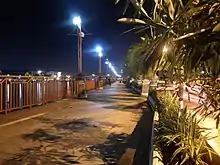
There are several city parks and public spaces in the city, one of the most notable being Siring Park, located in the center of the city. Sometimes referred to by locals as "0 Kilometer Park", the park is located on the shores of the Martapura River and also acts as a waterfront for the river with docks for small boats in the river. Facilities in the park include a watchtower, several gazebos, pedestrian roads, and skateboard parks. In front of the park, there is an urban bus stop used by both Trans Banjarmasin & BRT Banjarbakula bus companies.[51] In addition, the park includes one of the city's landmarks, a 6.5 m (21 ft) statue of a bekantan (Proboscis monkey) which is a native primate in the region. The park is also a center for street foods in the city during dusk.[52][53][54]
Other city parks include Kamboja Park, Bungas Banjarmasin Park, and Banua Anyar Public Space. Located 2 km (1.2 mi) from the city center, Banua Anyar Public Space is specifically designed for toddlers and kids. It is located below Banua Anyar bridge and has facilities such as a kids' park, artificial soft grass to ensure child safety, and book reading corners.[55][56][57][58]
Others
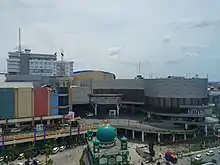
Several shopping malls are located in the city. The Duta Mall Banjarmasin is the largest in the province, and connected to a hotel called The Mercure Hotel. Located in Central Banjarmasin district, it occupies more than 42,000 m2 (450,000 sq ft) and consists of four stories. It is also surrounded by several other buildings housing stores, forming a complex with a total area of 80,000 m2 (860,000 sq ft).[59][60] Other entertainment centers in the city include Trans Studio Mini Banjarmasin, an indoor theme park which is owned by Trans Corp and malls such as Mitra Plaza, Lotte Mart, and Giant.[61] Mitra Plaza is one of the city's oldest modern shopping centers, and was a target of looting and destruction during the Banjarmasin riot of May 1997. It was renovated after the riot.[62] Other than modern shopping malls, according to Statistics Indonesia, as of 2019, there are 60 traditional markets registered in the city.[63]
Transportation
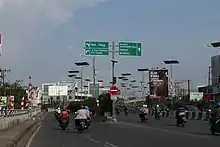
The city has 790.13 km (490.96 mi) of road, most of which have been paved with asphalt. It is connected to the Trans-Kalimantan Highway Southern Route, which connects it to other big cities such as Palangka Raya and Samarinda.[64] Kilometer 6 Bus Terminal is the main bus terminal for the city and the province, where buses for long inter-province routes gather.[65] Being old and overcrowded, the government relocated the main terminal to the newly built Kilometer 17 Bus Terminal in Gambut District, Banjar Regency. However, the new terminal is rarely used and many bus operators resisted the relocation because of the remoteness of the new terminal from the city center.[66]
Being divided by a big navigable river, speed boats on the river are also an important means of transportation within the city. Ride-hailing services such as Gojek and Grab are widespread. The city has three urban bus services, BRT Banjarbakula which connects it to the Greater Banjarmasin area and Trans Banjarmasin, which only serves the city proper.[67][68][69] As with other Indonesian cities, the city has angkots (shared taxis), which have been declining rapidly because of competition from online ride-hailing services, online taxis, and new public transportation services created by the city government.[70][71] On 22 December 2021, another urban bus system, Trans Banjarbakula, was launched which also covers the entire metropolitan area.[72][73]
The city is served by the Port of Trisakti, which is one of main ports in Indonesia and classified as class IA. The port has a passenger terminal for passenger ships to neighbouring islands such as Java and Sulawesi.[74][75] The closest airport is the Syamsudin Noor International Airport, which located inside Banjarbaru city, 29 km (18 mi) from Banjarmasin.[76]
Media
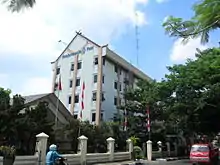
There are numerous newspapers, television stations, and radio based in Banjarmasin. The city is center of mass media in the province of South Kalimantan. Known established media groups such as Banjarmasin Post, Kalimantan Post, and Radar Banjarmasin existed since early New Order period, while numerous smaller independent media were founded mostly after Reformasi. Other example of news media are Barito Post, Mata Banua, Metro Banjar, and Kanal Kalimantan. In total, there were 47 registered news media including printed and online, 36 tabloids, and 4 magazines in the city.[77]
In television sector, outside of nationwide networks both private and state-owned, there are local television stations focused mostly on local news. State-owned television network TVRI has local branch for South Kalimantan located in Banjarmasin, while Duta TV and Banjar TV, two most prominent local channels, are private.[78][79][80][81]
The city also has a branch of Radio Republik Indonesia, an Indonesian state-owned radio network.[82] According to the government source, there are 21 formally registered radio station.[81]
References
- "Tagline Baru dan Pasar Terapung". Banjarmasin Post (in Indonesian). Archived from the original on 28 June 2021. Retrieved 28 June 2021.
- zagitanank. "Post – Walikota Narasumber APIP di Inspektorat Kota". Website Berita Banjarmasin (in Indonesian). Archived from the original on 31 August 2021. Retrieved 28 June 2021.
- Badan Pusat Statistik, Jakarta, 2023, Kota Banjarmasin Dalam Angka 2023 (Katalog-BPS 1102001.6371)
- "Indeks Pembangunan Manusia Kota Banjarmasin, Badan Pusat Statistik, 2018". Archived from the original on 25 December 2018. Retrieved 25 December 2018.
- Biro Pusat Statistik, Jakarta, 2011.
- Badan Pusat Statistik, Jakarta, 2021.
- "Profil Kota Banjarmasin | BPK RI Perwakilan Provinsi Kalimantan Selatan". Archived from the original on 8 May 2021. Retrieved 8 May 2021.
- Omed, Kata (25 May 2020). "Daftar 10 Kota Besar di Kalimantan". KATA OMED. Archived from the original on 1 November 2020. Retrieved 21 May 2021.
- "PU-net". perkotaan.bpiw.pu.go.id. Archived from the original on 10 May 2021. Retrieved 8 May 2021.
- "Banjarmasin Dalam Angka 2021". banjarmasinkota.bps.go.id. Archived from the original on 10 May 2021. Retrieved 8 May 2021.
- Sejarah Daerah Kalimantan Selatan (History of South Kalimantan Region). Department of Education and Cultural Affairs (Indonesia). 1978.
- "Asal Usul Nama Kota Banjarmasin dari Sosok Ini". Banjarmasin Post (in Indonesian). Archived from the original on 8 May 2021. Retrieved 8 May 2021.
- bpcbkaltim (19 February 2020). "Usia Candi Laras". Balai Pelestarian Cagar Budaya Kalimantan Timur. Archived from the original on 8 May 2021. Retrieved 8 May 2021.
- "The source of power of the Dayak Ma'anyan Tribes' political". Archived from the original on 10 May 2021. Retrieved 8 May 2021.
- Raditya, Iswara N. "Jejak Panjang Nan Sarunai, Kerajaan Purba di Kalimantan". tirto.id (in Indonesian). Archived from the original on 8 May 2021. Retrieved 8 May 2021.
- "Kerajaan Banjar: Sejarah, Pendiri, Masa Jaya dan Raja". VOI – Waktunya Merevolusi Pemberitaan (in Indonesian). Archived from the original on 10 May 2021. Retrieved 8 May 2021.
- Barjie B, Ahmad (2015). Perang Banjar Barito. Penakita Publisher. ISBN 9786021285558.
- Noorlander, J.C. (1935). Banjarmasin en de Compagnie in de Tweede Helft der 18 de Eeuw. Leiden: N. Dubbeldeman. p. 5.
- "Sejarah Kesultanan Dan Budaya Banjar" (PDF). Archived (PDF) from the original on 10 May 2021. Retrieved 8 May 2021.
- Elson, Robert Edward (2009). The Idea of Indonesia (in Indonesian). Penerbit Serambi. ISBN 978-979-024-105-3. Archived from the original on 10 May 2021. Retrieved 8 May 2021.
- Johnston, Mark (16 April 2000). Fighting the Enemy: Australian Soldiers and Their Adversaries in World War II. Cambridge University Press. ISBN 978-0-521-78222-7. Archived from the original on 8 May 2021. Retrieved 8 May 2021.
- Aufa, Naimatul; Anhar, Pakhri (18 January 2016). "Studi Tata Ruang Kota Rancangan Van Der Pijl Kasus: Kota Banjarbar, Kalimantan Selatan". Tataloka. 14 (2): 142–155. doi:10.14710/tataloka.14.2.142-155 (inactive 1 August 2023). ISSN 2356-0266. Archived from the original on 10 May 2021. Retrieved 8 May 2021.
{{cite journal}}: CS1 maint: DOI inactive as of August 2023 (link) - Ranter, Harro. "ASN Aircraft accident CASA/Nurtanio NC-212-A4 Aviocar 100 PK-VSO Banjarmasin-Sjamsudin Noor Airport (BDJ)". aviation-safety.net. Aviation Safety Network. Archived from the original on 10 November 2005. Retrieved 28 November 2020.
- "As Indonesia holds an election, a small town in Borneo burns". The Independent. 22 October 2011. Archived from the original on 8 December 2017. Retrieved 8 May 2021.
- "The Nation". news.google.com. Archived from the original on 8 January 2021. Retrieved 8 May 2021.
- Mydans, Seth (26 May 1997). "In Indonesia, A Deadly End To a Campaign". The New York Times. ISSN 0362-4331. Archived from the original on 28 December 2017. Retrieved 8 May 2021.
- 130 looters die in fire during Indonesian riot – CNN Archived 2012-04-06 at the Wayback Machine. Articles.cnn.com (1997-05-25). Retrieved on 2011-06-12.
- "Sejarah Hari Ini: 22 Tahun Lalu Ratusan Orang Meninggal akibat Tragedi Jumat Kelabu di Banjarmasin". Tribun Kaltim (in Indonesian). Archived from the original on 8 May 2021. Retrieved 8 May 2021.
- RI, Setjen DPR. "Paripurna DPR Setujui 7 RUU Provinsi". www.dpr.go.id (in Indonesian). Archived from the original on 19 February 2022. Retrieved 19 February 2022.
- Agency, ANTARA News. "Banjarbaru resmi ibukota Provinsi Kalimantan Selatan". ANTARA News Kalimantan Selatan. Archived from the original on 19 February 2022. Retrieved 19 February 2022.
- "Kondisi Umum Banjarmasin". docplayer.info. Archived from the original on 8 May 2021. Retrieved 8 May 2021.
- "World Meteorological Organization Climate Normals for 1991–2020". World Meteorological Organization. Retrieved 19 October 2023.
- "UU 22 1999" (PDF). Archived (PDF) from the original on 16 April 2021. Retrieved 8 May 2021.
- "UU 8 2015" (PDF). Archived (PDF) from the original on 26 February 2021. Retrieved 8 May 2021.
- "PP No. 17 Tahun 2018 tentang Kecamatan [JDIH BPK RI]". peraturan.bpk.go.id. Archived from the original on 17 April 2021. Retrieved 16 April 2021.
- Government Law No.19 1998
- "KepKPU Kalsel 285" (PDF). Archived (PDF) from the original on 10 December 2018. Retrieved 9 May 2021.
- "Indikator Ekonomi Banjarmasin 2020". banjarmasinkota.bps.go.id. Archived from the original on 9 May 2021. Retrieved 9 May 2021.
- "PDRB Kota Banjarmasin Menurut Lapangan Usaha (2016–2020)". banjarmasinkota.bps.go.id. Archived from the original on 9 May 2021. Retrieved 9 May 2021.
- Profil dan Analisis Hasil Sensus Penduduk 2010 dan Proyeksi Penduduk 2010–2020 Kota Banjarmasin
- Alamin, Rabul; Adyatma, Sidharta; Arisanty, Deasy (16 August 2016). "Faktor Yang Mempengaruhi Mobilitas Ulang Ulang Alike Penduduk Kecamatan Tamban Menuju Kota Banjarmasin". Jurnal Pendidikan Geografi. 2 (1). doi:10.20527/jpg.v2i1.1463 (inactive 1 August 2023). ISSN 2685-6395. Archived from the original on 31 August 2021. Retrieved 9 May 2021.
{{cite journal}}: CS1 maint: DOI inactive as of August 2023 (link) - "Statistik Kesejahteraan Rakyat Kota Banjarmasin 2020". banjarmasinkota.bps.go.id. Archived from the original on 9 May 2021. Retrieved 9 May 2021.
- "Rumah Sakit Umum Daerah Ulin". rsulin.kalselprov.go.id. Archived from the original on 9 May 2021. Retrieved 9 May 2021.
- "Kota Banjarmasin". Kongres Kebudayaan Indonesia 2018 (in Indonesian). 3 December 2018. Archived from the original on 9 May 2021. Retrieved 9 May 2021.
- klikkalimantan (3 February 2020). "2,5 Juta Jamaah Diperkirakan Hadir pada Haul ke-15 Guru Sekumpul". Klik Kalimantan (in Indonesian). Archived from the original on 5 May 2021. Retrieved 9 May 2021.
- "Berbagai Persiapan Dilakukan Untuk Pelaksanaan Haul Guru Sekumpul". Pemerintah Kabupaten Banjar (in Indonesian). Archived from the original on 1 May 2021. Retrieved 9 May 2021.
- "Pasar Terapung, Wisata Bisnis di Atas Sungai". www.jpnn.com (in Indonesian). 21 April 2010. Archived from the original on 9 May 2021. Retrieved 9 May 2021.
- M. Gigih Tulus Pasaribu (2004). "Gedung Kesenian Pusat Pagelaran Lima Seni Budaya Banjar Banjarmasin Kalimantan Selatan". Archived from the original on 10 May 2021. Retrieved 9 May 2021.
{{cite journal}}: Cite journal requires|journal=(help) - "Taman Budaya Kalsel siapkan pergelaran dihari musik nasional 2021". ANTARA News Kalimantan Selatan. Antara News Agency. Archived from the original on 9 May 2021. Retrieved 9 May 2021.
- "Taman Budaya, Tempatnya Menyaksikan Beragam Hiburan di Banjarmasin". Majalahteras.com. 8 June 2015. Archived from the original on 9 May 2021. Retrieved 9 May 2021.
- "Sementara Gratis! Ini Rute Perlintasan Bus Trans Banjarmasin". Kanal Kalimantan (in Indonesian). 17 February 2020. Archived from the original on 12 December 2020. Retrieved 21 May 2021.
- "Skater Banjarmasin Tak Mau Pakai Skateboard Park Siring, Ada Apa Ya?". Banjarmasin Post (in Indonesian). Archived from the original on 7 February 2021. Retrieved 21 May 2021.
- "10 Taman di Banjarmasin yang Cocok untuk Refreshing – Borneo ID". 23 July 2020. Archived from the original on 31 August 2021. Retrieved 21 May 2021.
- "Serunya Berkelana dengan Kapal di Siring Kota Banjarmasin". Traveling Yuk. 1 February 2020. Archived from the original on 31 August 2021. Retrieved 21 May 2021.
- "Kalselpedia: Daftar Taman di Kota Banjarmasin, Tempat Bersantai Nan Nyaman". Banjarmasin Post (in Indonesian). Archived from the original on 24 August 2020. Retrieved 21 May 2021.
- "RPTRA Banua Anyar Jadi Primadona Baru untuk Ngabuburit". koranbanjar.NET (in Indonesian). 30 May 2018. Archived from the original on 2 June 2018. Retrieved 21 May 2021.
- "RPTRA Banua Anyar, Taman Bawah Jembatan di Kota Banjarmasin, Main Sepuasnya Tanpa Dipungut Bayaran". Banjarmasin Post (in Indonesian). Archived from the original on 23 February 2020. Retrieved 21 May 2021.
- "RPTRA Banua Anyar, Benua Anyar – Taman (Park)". indowhere.org. Archived from the original on 31 August 2021. Retrieved 21 May 2021.
- "Banyak Pusat Perbelanjaan di Banjarmasin, Tapi Ini Istimewanya Duta Mall". Tribunnews.com (in Indonesian). Archived from the original on 27 August 2018. Retrieved 21 May 2021.
- "Home". Duta Mall. Archived from the original on 1 November 2020. Retrieved 21 May 2021.
- "Trans Studio Mini Banjarmasin Hadirkan 200 Lebih Wahana Bermain Keluarga". Banjarmasin Post (in Indonesian). Archived from the original on 29 July 2018. Retrieved 21 May 2021.
- "Mall di Banjarmasin: Daftar Pusat Perbelanjaan di Banjarmasin". Ayojelajah.com. 16 July 2019. Archived from the original on 31 August 2021. Retrieved 21 May 2021.
- "Nama Pasar Yang Terdaftar di Kota Banjarmasin". banjarmasinkota.bps.go.id. Archived from the original on 22 May 2021. Retrieved 21 May 2021.
- "Jalur Trans Kalimantan Kalsel-Kaltim". 2 August 2012. Archived from the original on 10 May 2021. Retrieved 9 May 2021.
- Rizani, M. Maulana (1998). "Pengembangan Terminal Induk Km.6 di Banjarmasin". Archived from the original on 22 May 2021. Retrieved 21 May 2021.
{{cite journal}}: Cite journal requires|journal=(help) - "Persepsi Sopir Angkutan Kota Banjarmasin Terhadap Pemindahan Terminal Induk Kilometer 6 Banjarmasin Ke Terminal Induk Kilometer 17 Gambut". Archived from the original on 22 May 2021. Retrieved 21 May 2021.
- "Bus Trans Banjarmasin Resmi Diluncurkan, Cek Waktu Operasionalnya". Kanal Kalimantan (in Indonesian). 17 February 2020. Archived from the original on 9 May 2021. Retrieved 9 May 2021.
- "Dikenal Sebagai Tayo, BRT Dishub Kalsel Mulai Operational untuk Umum Hari ini, Gratis!". Banjarmasin Post (in Indonesian). Archived from the original on 25 April 2021. Retrieved 9 May 2021.
- "Daftar Delivery Makanan Banjarmasin Terbaru (Oktober 2020) – GoFood". www.gojek.com. Archived from the original on 9 May 2021. Retrieved 9 May 2021.
- "Nasib Angkot di Banjarmasin, Sepi Penumpang Ternyata Bukan karena Taksi Online, Ini Penyebabnya". Banjarmasin Post (in Indonesian). Archived from the original on 31 May 2018. Retrieved 22 May 2021.
- "Trans Banjarmasin Beroperasi, Sopir Angkot: Lambat Laun Kami Mati Dengan Sendirinya" (in Indonesian). Archived from the original on 2 December 2020. Retrieved 22 May 2021.
- prokal.co. "Bus Trans Banjarbakula Mulai Beroperasi | Radar Banjarmasin". kalsel.prokal.co (in Indonesian). Archived from the original on 4 January 2022. Retrieved 4 January 2022.
- "Trans Banjarbakula Diresmikan, Ini Harapan Wabup Rahmadian Noor". Banjarmasinpost.co.id (in Indonesian). Archived from the original on 30 January 2022. Retrieved 4 January 2022.
- "Banjarmasin- PT Pelindo III". Archived from the original on 9 May 2021. Retrieved 9 May 2021.
- Muhamad, Asep. "Penumpang Angkutan Laut Di Pelabuhan Trisakti Banjarmasin Melonjak". dephub.go.id. Archived from the original on 9 May 2021. Retrieved 9 May 2021.
- "Jalan Alternatif ke Bandara Syamsudin Noor di Km 28–30, Siapkan Dana Kontruksi Rp 60 Miliar". Banjarmasin Post (in Indonesian). Archived from the original on 9 May 2021. Retrieved 9 May 2021.
- Sari, Nining Nadya Rukmana (2016). "Ekonomi Politik Media Cetak di Kalimantan Selatan". Jurnal Penelitian Pers Dan Komunikasi Pembangunan (in Indonesian). 20 (2): 121–142. doi:10.46426/jp2kp.v20i2.49. ISSN 2527-693X. Archived from the original on 3 January 2022. Retrieved 3 January 2022.
- Yulianti, Hesti Dwi; Masduki, Masduki (2008). "Analisis Model Produksi Berita Televisi Lokal: Studi TVRI Stasiun Penyiaran Kalimantan Selatan dan Banjar TV". Jurnal Komunikasi (in Indonesian). 3 (1): 101–114. ISSN 2548-7647. Archived from the original on 28 June 2021. Retrieved 28 June 2021.
- "Gambaran Umum TVRI Kalsel" (PDF). Archived (PDF) from the original on 28 June 2021. Retrieved 28 June 2021.
- "About Duta Televisi" (in Indonesian). Archived from the original on 22 April 2021. Retrieved 28 June 2021.
- "Informasi Banua". smart.kalselprov.go.id. Archived from the original on 28 June 2021. Retrieved 28 June 2021.
- Adzra, Gusti Athifah (27 September 2020). "Pengaruh Penyiaran Radio Republik Indonesia Banjarmasin". Jurnal Mutakallimin: Jurnal Ilmu Komunikasi. 2 (2). Archived from the original on 28 June 2021. Retrieved 28 June 2021.
External links
 Banjarmasin travel guide from Wikivoyage
Banjarmasin travel guide from Wikivoyage
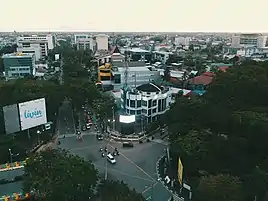

.jpg.webp)
